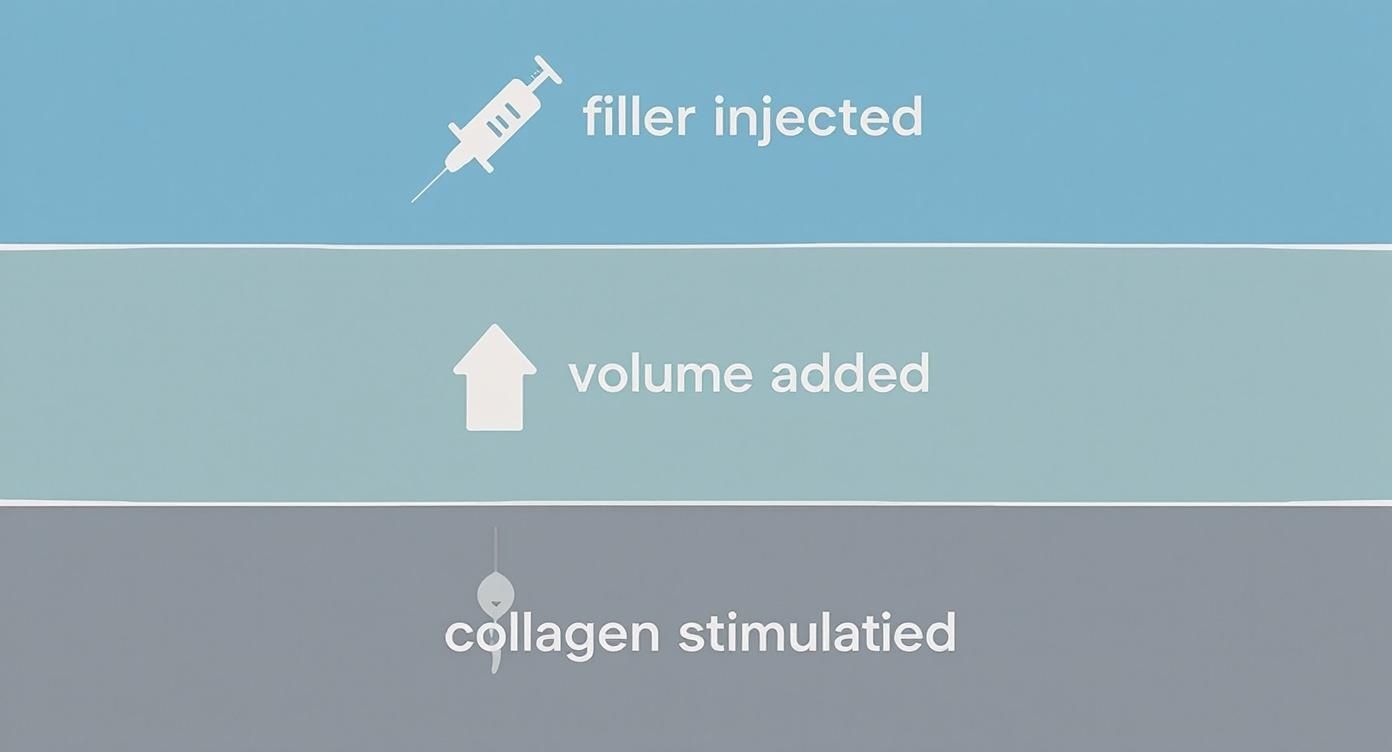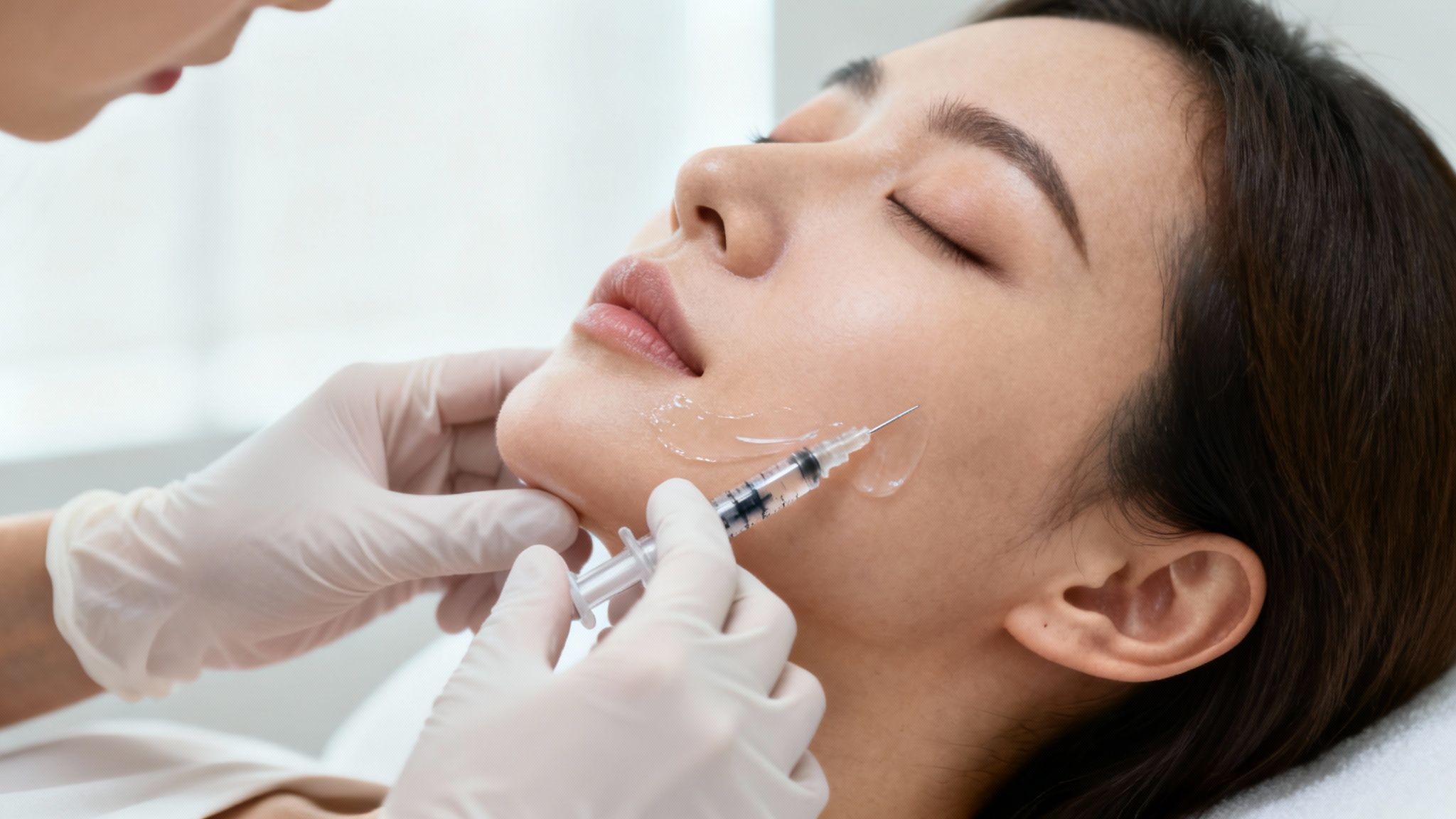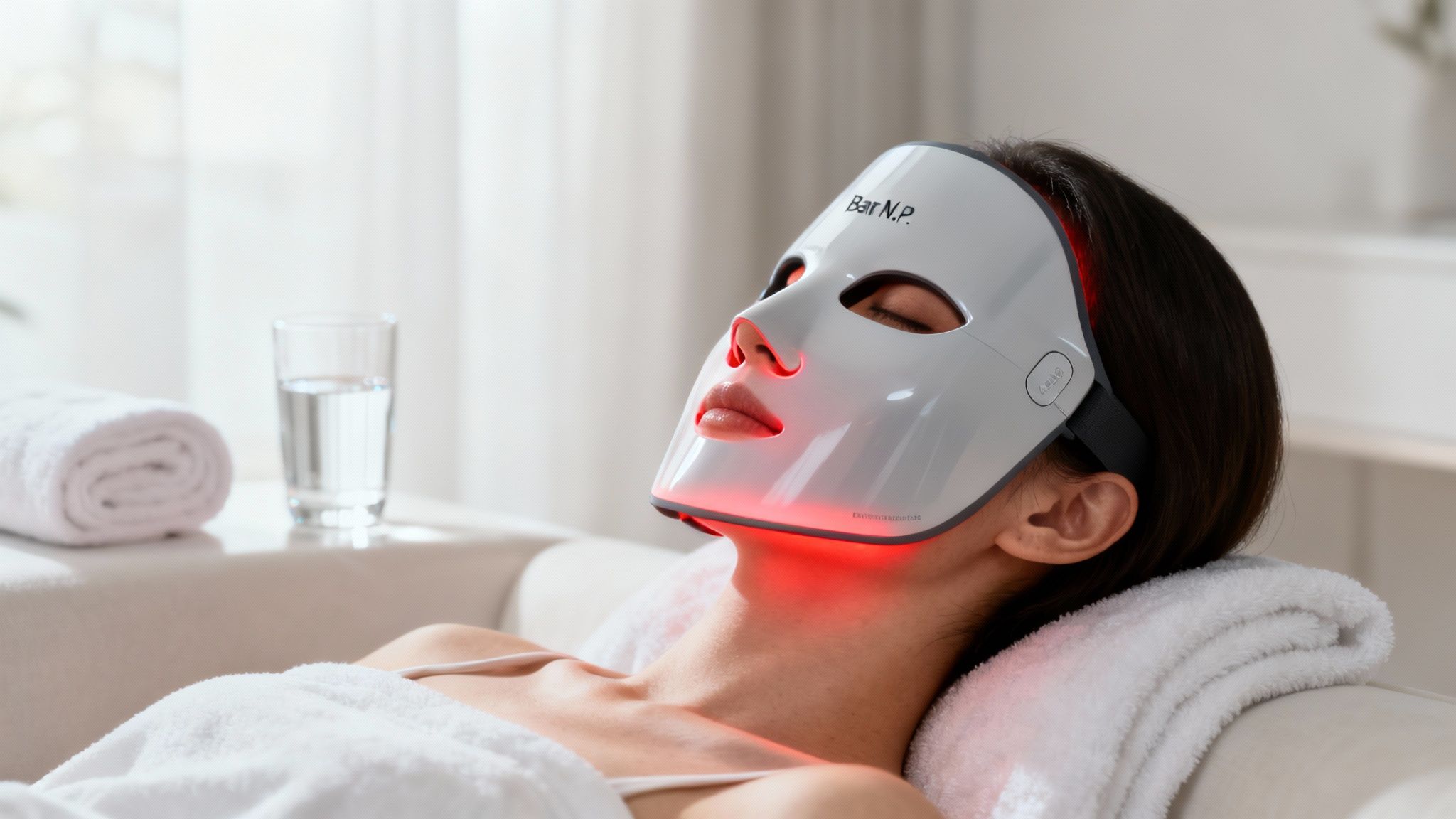
Dermal fillers are one of the most effective non-surgical treatments for marionette lines. These are injectable gels, usually made from hyaluronic acid, that work by quite literally refilling lost volume from beneath the skin.
Think of it like adding support back under a deflated cushion. The filler gently lifts the skin from within, smoothing out those deep creases that run from the corners of your mouth to your chin. The result is a much softer, more youthful appearance.
Understanding Marionette Lines and Why They Form

We've all seen them—those vertical lines that run from the outer corners of the mouth down toward the jawline. They get their name from marionette string puppets, which have similar lines where their jaws are hinged. While they are a completely normal part of aging, they can unintentionally make you look sad, angry, or just tired, even when you feel fantastic.
These lines don't just show up one morning. They’re the result of several factors working together over time, gradually changing the landscape of your face. Getting to the root of these causes is the first step to treating them effectively.
The Role of Aging and Volume Loss
The main culprit behind marionette lines is simply the natural aging process. As the years go by, our skin’s production of collagen and elastin—the two key proteins that keep it firm, springy, and plump—starts to slow down. Imagine collagen as the scaffolding holding up your skin; as it weakens, everything starts to sag a bit.
At the same time, we lose facial volume, especially in our cheeks. The youthful fat pads that give our face structure begin to shrink and slide downwards, causing the skin above to droop. This gravitational pull deepens the folds around the mouth, creating those distinct lines.
It’s this combination of factors that creates the perfect storm for marionette lines:
- Reduced Skin Elasticity: Without enough elastin, your skin loses its ability to "snap back" into place.
- Collagen Depletion: The loss of this structural protein makes the skin thinner and less supportive.
- Facial Fat Atrophy: When the cheeks lose volume, they no longer hold up the lower face, causing sagging.
How Muscle Movement and Lifestyle Contribute
Of course, it’s not just about aging. Everyday muscle movements play a huge part. The muscles that pull down the corners of your mouth (known as the depressor anguli oris or DAO muscles) are constantly at work when you frown or make other expressions. Over thousands of repetitions, this downward pull can etch permanent lines into the skin.
Your lifestyle habits also have a big say in the matter. Sun exposure is public enemy number one for healthy skin, as UV rays break down collagen and elastin at a much faster rate. Other factors like smoking, dramatic weight changes, and even your genetics can determine when and how severely these lines appear.
Key Insight: Marionette lines are almost never caused by a single thing. They are the result of a complex dance between volume loss, sagging skin, muscle activity, and your daily habits.
This is exactly why treatments like filler for marionette lines are so transformative. Instead of just treating the skin's surface, dermal fillers tackle one of the primary root causes: lost volume. By strategically placing a smooth gel (like hyaluronic acid) beneath the skin, an experienced injector can rebuild that lost support structure. This process lifts the sagging skin, essentially filling in the crease from below for a naturally smooth and rejuvenated look.
How Fillers Erase Marionette Lines from Within
To really get why a filler for marionette lines is so effective, you have to look deeper than just the skin's surface. This treatment isn't about covering up a problem. It’s about rebuilding your skin's foundational support system from the inside out, tackling the root cause: lost volume.
Think of your skin like a beautiful fabric stretched over a supportive frame. As we age, that frame—made of collagen, fat, and bone—starts to lose its density. The fabric then begins to sag and fold, creating creases. Dermal fillers act like targeted reinforcements, strategically placed to lift that fabric back up, smoothing away the lines.
The Science of Hyaluronic Acid Fillers
The overwhelming majority of today's best fillers are made from hyaluronic acid (HA), a substance your body already makes to keep tissues hydrated and plump. HA is a moisture superstar, able to hold up to 1,000 times its weight in water. This incredible hydrating power is the secret to its rejuvenating effects.
When a skilled practitioner injects an HA gel into the tissue around your marionette lines, two amazing things happen almost instantly:
- Immediate Plumping: The gel itself adds instant physical volume. It acts like a tiny, soft cushion that lifts the skin and physically fills in the crease, giving you that immediate smoothing you see right after your appointment.
- Deep Hydration: The hyaluronic acid then gets to work drawing moisture into the area. This hydrates the skin from deep within, improving its texture, bounce, and overall radiance for a healthier, more supple look.
You’re probably already familiar with HA from topical skincare. High-quality products like a Hyaluronic Acid face cream are fantastic for locking in moisture on the surface. Injectable fillers take it to the next level by delivering that hydration and support deep within the dermal layers where it’s needed most.
More Than Just a Temporary Fix
The immediate lift is impressive, but the benefits of HA fillers don't end there. The injection process triggers a controlled healing response in your skin. This subtle signal tells your body to ramp up its own production of new collagen.
Collagen is the protein that gives your skin its strength and structure. As your body builds new collagen fibers around the filler, it creates a stronger, more resilient framework. This means that even after the filler naturally breaks down months later, you’re left with skin that's in better condition than when you started. It's a dual-action approach that gives you both an instant fix and long-term improvement. For a deeper dive into this mechanism, you can read our guide on how dermal fillers work.
The Dual-Action Effect: Hyaluronic acid fillers deliver a one-two punch against marionette lines. They provide immediate volume for instant smoothing while also stimulating your body's own collagen for lasting skin improvement.
This smart, biocompatible approach is why the treatment is exploding in popularity. The global dermal fillers market was valued at $6.78 billion and is expected to climb to $12.79 billion by 2032. This isn't just a trend; it's a reflection of how many people want non-invasive ways to get natural-looking results with little to no downtime.
Ultimately, using a filler for marionette lines is about skillfully restoring what time and gravity have diminished. It works in harmony with your body to rebuild support, rehydrate from within, and soften the lines that can make you look tired or sad. The result is a refreshed, natural appearance that finally matches how you feel on the inside.
Choosing the Right Filler for Your Marionette Lines
Stepping into the world of dermal fillers can feel a bit like walking into a high-end boutique—so many beautiful options, each promising incredible results. When it comes to finding the best filler for marionette lines, the secret isn't about finding a single "best" product. It's about finding the right one for your unique facial structure, skin quality, and goals.
Not all fillers are created equal. Understanding what makes them different is the key to achieving that refreshed, natural look everyone wants.
The vast majority of today’s top-tier fillers are made from hyaluronic acid (HA), a gel-like substance our bodies naturally produce to keep skin hydrated and plump. You’ve probably heard of brands like Juvéderm and Restylane—they’re household names for a reason. They offer a whole family of HA fillers, each with a different thickness and structure designed for specific jobs.
Think of it like an artist’s toolkit. Some fillers are dense and firm, perfect for building support deep in the cheeks to physically lift the lower face. Others are soft and flexible, designed to delicately fill the lines themselves without looking obvious or stiff. A great injector knows exactly which tools to use—and often combines them—to create a balanced, harmonious result.
Hyaluronic Acid: The Gold Standard
Hyaluronic acid fillers are the go-to for marionette lines, and for good reason. They have an excellent safety profile and deliver incredibly natural-looking results. They don't just add volume on the spot; they also attract moisture to the area, improving skin health from the inside out.
It's no surprise that the demand for these advanced HA fillers is booming. The hyaluronic acid market in North America is projected to grow at a CAGR of 10.14% as more people seek treatments that are both effective and safe.
Within the HA category, you'll find different product families, each with its own personality:
- Juvéderm Family: Known for its smooth, consistent gel. A product like Juvéderm Vollure™ is a popular choice for marionette lines because it strikes the perfect balance between sturdiness and flexibility, so you can still make natural facial expressions. For deeper support, an injector might use Juvéderm Voluma™ in the cheeks to create lift.
- Restylane Family: These fillers often have a slightly more granular, cohesive feel. Restylane Defyne and Restylane Refyne are fantastic for marionette lines because they’re engineered with XpresHAn Technology™, allowing them to stretch and move with your face. The result looks soft and natural, even when you're laughing or talking.
To get a better sense of all the different formulations and what they do best, you can read more about the various Juvéderm filler types.
Other Filler Options to Consider
While HA fillers are definitely the main event, they aren't the only option. In some cases, a different type of filler might be recommended for longer-lasting or more structural results.
One of the most effective alternatives is Calcium Hydroxylapatite (CaHA), sold under the brand name Radiesse®. This filler is made of tiny calcium-based spheres suspended in a smooth gel. Not only does it provide immediate volume, but it also acts as a scaffold, encouraging your body to produce its own fresh collagen. This makes it a powerhouse for tackling deeper volume loss and providing long-term support.
This infographic breaks down how fillers work to refresh and rejuvenate the skin.

As you can see, it's a two-part process: you get the immediate plumping effect, followed by a long-term improvement as your skin rebuilds itself.
To help you understand the main players, here’s a quick comparison of the most popular filler types used for marionette lines.
Comparing Common Dermal Fillers for Marionette Lines
| Filler Type | Active Ingredient | Average Longevity | Key Benefits |
|---|---|---|---|
| Hyaluronic Acid (HA) | Hyaluronic Acid | 9-18 months | Natural look, reversible, excellent for fine-tuning and adding hydration. Moves well with facial expressions. |
| Calcium Hydroxylapatite (CaHA) | Calcium Hydroxylapatite | 12-18+ months | Provides immediate volume and stimulates long-term collagen production. Great for deeper folds and structural support. |
Ultimately, whether you need a soft, flexible HA filler or a robust collagen-stimulator like CaHA depends entirely on your specific needs.
Expert Takeaway: The best filler is always a personal choice. It depends on how deep your lines are, your skin’s thickness, and how much volume you've lost in the surrounding areas. A detailed consultation with an experienced Nurse Practitioner like Barb N.P. is the only way to create a treatment plan that’s perfectly tailored to you.
The goal is to choose a filler for marionette lines that blends seamlessly into your own tissue. Whether it’s a soft HA gel to smooth the surface or a collagen-booster for deep support, the right product will restore volume and erase those creases without leaving a trace.
What to Expect During Your Filler Treatment

Deciding to get a filler for marionette lines is an exciting step, but it's totally normal to wonder what the appointment itself is actually like. Knowing the process from start to finish can help turn any nerves into pure anticipation.
From the first conversation to the final look in the mirror, the entire experience is designed to be comfortable, clear, and focused on you. Understanding what a great treatment journey looks like also empowers you to choose a provider who puts your safety and results first. After all, a professional and thorough approach is the secret to a natural-looking outcome that makes you feel amazing.
The Initial Consultation
Honestly, the most important part of your treatment happens before a syringe is even opened. This is your consultation, where you and your provider—like an expert Nurse Practitioner from Barb N.P.—become a team. It's so much more than a quick chat; it's a deep dive into your goals, facial anatomy, and medical history.
A top-notch consultation should always cover:
- A Real Conversation: You’ll talk about what you see in the mirror, what bothers you about your marionette lines, and what your ideal outcome looks like.
- A Professional Assessment: Your provider will analyze your facial structure, skin quality, and even how your muscles move. They aren't just looking at the lines themselves but at the root causes, like volume loss in the cheeks that might be contributing.
- A Custom Plan: Based on their assessment, they'll recommend the exact type and amount of filler for you. They should explain why they chose a specific product—maybe one for structure, another for flexibility—so you understand the logic.
- Total Transparency: You should walk away with clear information on the procedure, potential side effects, aftercare, and the final cost. This is the time to ask every single question you can think of.
This first meeting truly sets the stage for a fantastic result. It ensures you feel heard, informed, and completely confident in the plan before moving forward.
Preparing for Your Appointment
Once you’re booked, getting ready is simple but key to minimizing any potential bruising and ensuring a smooth recovery. Your provider will give you a specific list of things to avoid for about a week before your appointment.
Typically, you’ll be asked to pause:
- Blood-thinning medications like aspirin and ibuprofen.
- Certain supplements known to thin the blood, like fish oil, vitamin E, and ginkgo biloba.
- Alcohol for at least 24-48 hours before your treatment.
Following these simple guidelines helps prepare your skin for the treatment and can make a big difference in reducing any post-injection swelling or bruising.
The Injection Process Step by Step
On treatment day, the entire focus is on your comfort and getting a precise, beautiful result. The actual injection process is surprisingly fast, often taking just 15 to 30 minutes from start to finish.
Here’s a quick breakdown of how it goes:
- Cleansing and Numbing: First things first, your skin will be thoroughly cleansed to eliminate any risk of infection. Then, a strong topical numbing cream is applied to the area to make sure you’re comfortable and feel as little as possible.
- Mapping It Out: Your injector will carefully mark the exact points on your face where the filler will be placed. Think of it as a roadmap for a perfectly symmetrical and balanced result.
- The Injections: Using an ultra-fine needle or a smooth, blunt-tipped cannula, the filler is skillfully injected into the targeted zones. You might feel a tiny pinch or a bit of pressure, but between the numbing cream and the lidocaine mixed into most modern fillers, the process is very easy to tolerate.
- Gentle Sculpting: Immediately after injecting, your provider might gently massage or mold the filler. This ensures it settles perfectly into place for a smooth, seamless contour.
Patient Comfort is Key: A great injector always prioritizes a comfortable experience. With good numbing and a gentle hand, getting a filler for marionette lines is a straightforward and minimally invasive procedure.
The best part? You’ll see the change right away. The lines will be visibly softer, and the whole area will look smoother and more lifted. While you might have a little redness or minor swelling, the initial improvement is immediate and always exciting to see.
Extending Your Results with Smart Aftercare

Getting filler for marionette lines is an exciting first step, but the real magic happens when you protect that investment. Think of it like a beautiful new painting—the aftercare is the protective varnish that keeps it looking fresh and vibrant for as long as possible. A few smart habits can make all the difference in your recovery and the longevity of your results.
The first 24 to 48 hours are all about letting the filler settle perfectly into place. Your provider will give you specific instructions, but a few rules are universal. It's wise to skip strenuous workouts, avoid saunas or excessive sun, and hold off on that glass of wine. Why? These things can increase blood flow to the face, which might dial up swelling or bruising.
It's also a good idea to avoid putting too much pressure on the treated areas. This means trying to sleep on your back and being extra gentle when cleansing your face. If your skin is sensitive after the treatment, the right makeup is key. Choosing the best natural makeup for sensitive skin can help you avoid irritation while your skin heals beautifully.
Long-Term Strategies for Skin Health
Once you're past the initial recovery, the focus shifts to long-term maintenance. This is where you can truly enhance and prolong your results. The health of your skin plays a huge role in supporting the filler and keeping everything looking smooth and lifted. It’s about building a routine that actively supports your skin's underlying structure.
The best approach combines professional treatments with consistent at-home care. Medical-grade skincare is a must, but you can take it a step further by using advanced devices that support your skin's natural regenerative processes. This is where technology becomes your skin's best friend, working in perfect harmony with your filler treatment.
Key Takeaway: Aftercare isn't just a list of things to avoid. It’s a proactive strategy to boost your skin’s health from the inside out, complementing the filler’s effects and helping you love your results for months to come.
This brings us to one of the most effective ways to support long-term skin health and boost collagen: LED light therapy.
Enhance Your Investment with the Barb N.P. LED Facial Mask
To really elevate your skincare game, consider adding the Barb N.P. LED Facial Mask to your routine. This isn't just another beauty gadget; it’s a powerful tool designed to work alongside treatments like dermal fillers to boost your skin's natural vitality.
The mask has three different light settings, each tackling specific skin concerns. If you’ve had filler for marionette lines, the red light setting is your new best friend. Red light therapy is known for its ability to penetrate deep into the skin, where it encourages fibroblast cells to kick collagen production into high gear. This new collagen creates a stronger, more resilient framework for your skin, beautifully enhancing the filler's lifting effects.
It’s designed to be an effortless part of your routine:
- Completely Wireless: You can move around freely and go about your evening—no being stuck next to an outlet.
- Designed for Comfort: The mask is crafted to sit comfortably and securely on your face, making your treatment session a truly relaxing experience.
- 3 Lighting Settings: Customize your session by choosing red light for anti-aging, blue light to fight acne-causing bacteria, or amber light to calm redness and promote healing.
Using the mask just a few times a week is a simple, non-invasive way to protect your investment. It helps maintain skin firmness and health, ensuring your filler results look absolutely fantastic for as long as possible.
Investing in Your Results: Cost and Longevity
Let's talk about the practical side of getting filler for marionette lines. Knowing how it works is one thing, but understanding the investment—both in terms of cost and how long you'll enjoy the results—is just as crucial. Seeing the full picture helps you plan and treat this as a sustainable part of your self-care routine.
The price of dermal fillers isn’t a simple, one-size-fits-all number. It’s a reflection of several key factors that all contribute to the quality and safety of your outcome. A huge part of what you're paying for is the injector's expertise. An experienced provider with a deep, nuanced understanding of facial anatomy will naturally command a higher fee for their skill and artistry.
Your geographic location also plays a role, with clinics in major cities often having a different pricing structure than those in smaller towns.
What Factors Influence the Price Tag?
The specific type and amount of filler used are also major variables. A thicker, more robust filler designed for deep structural support will likely cost more than a softer, more flexible one used for fine-tuning surface lines. Because every face is unique, the volume of product needed will be completely customized to you.
On average, you can expect the cost of dermal filler for marionette lines to range from $500 to $2,000 per session. This range accounts for everything from the injector's experience to the specific filler chosen. To get a more detailed look at what goes into the pricing, you can discover more insights about filler costs on dentalsolutionsofcp.com.
How Long Can You Expect Results to Last?
Just as the cost varies, so does the longevity of your results. For most hyaluronic acid fillers, you can expect the smoothing and lifting effects to last anywhere from 9 to 18 months. How long it lasts for you depends on the specific product used, your body’s unique metabolism, and even your lifestyle.
Key Insight: Think of filler as an ongoing investment in your appearance. It’s not a one-and-done fix but a repeatable treatment that allows you to maintain a consistently refreshed and natural look over time.
Understanding this from the get-go helps you and your provider create a smart maintenance plan. By scheduling touch-up appointments before the filler has completely faded, you can keep your results looking seamless and ensure you always feel like the very best version of yourself.
Common Questions About Marionette Line Fillers
Even with all the facts, it’s totally normal to have a few more questions pop up. Think of this as your quick-reference guide to clear up any lingering thoughts and help you feel completely confident about your decision.
Is Getting Filler for Marionette Lines Painful?
Honestly, most people find the treatment very manageable. To make sure you're comfortable, your provider will start by applying a strong topical numbing cream to the area. You’ll feel it working pretty quickly.
On top of that, many of the best hyaluronic acid fillers today, like Juvéderm and Restylane, are already mixed with lidocaine. This means the anesthetic works from the inside out as the filler is injected, making the whole process surprisingly easy.
What Are the Potential Side Effects of Fillers?
The side effects are usually minor and don't stick around for long. The most common things you’ll see are temporary reactions right where the injections were done.
You might notice:
- A little bit of swelling or redness.
- Some tenderness if you press on the area.
- Minor bruising around the corners of your mouth.
These little things almost always clear up on their own within a few days, or a week at most. Serious complications are incredibly rare, especially when you’re in the hands of a qualified, experienced medical professional.
How Soon Will I See the Final Results?
This is the best part—you get a little instant gratification! You’ll see a visible softening of your marionette lines right after the appointment is over.
But the filler does need a little time to fully settle in and mesh with your skin’s tissue. Give it about one to two weeks for any initial swelling to completely disappear. That’s when you’ll see the final, beautifully polished results.
Final Takeaway: The secret to amazing, long-lasting rejuvenation is combining professional treatments with a great at-home skincare routine. When you support your skin’s health, you amplify the beautiful effects of your filler.
Can I Combine Fillers with Other Treatments?
Absolutely! In fact, the most natural-looking and impressive results often come from a combination approach. A skilled provider might suggest pairing fillers with another treatment to tackle all the factors contributing to your marionette lines.
For example, if overactive muscles are pulling down the corners of your mouth, a neuromodulator like Botox can work wonders. If you're curious about how these two popular injectables work differently, you can learn all about the difference between Botox and filler in our detailed guide. Adding at-home devices that boost skin health is also a fantastic way to support your results long-term.
At Barb N.P., we believe in creating personalized treatment plans that deliver beautiful, natural-looking results. To start your journey toward a refreshed appearance, book a consultation with Barb N.P. today by visiting https://barbnp.shop.

